How to Visit Iceland’s South Coast in Winter (Without a Car)
If you’re dreaming of visiting Iceland’s South Coast in winter – from powerful waterfalls to icy-blue glaciers – but you don’t have a car, don’t worry.
You can absolutely visit Iceland’s South Coast in winter without a car – without missing out on the highlights or hidden gems that make this stretch of Iceland’s coastline so special!
In January, I spent two full days exploring the Iceland South Coast solo (completely car-free) and, despite some wild weather conditions, it ended up being one of the most magical parts of my entire Iceland trip!
This blog post will show you exactly how to experience the very best of Iceland’s South Coast highlights in winter – even without your own wheels.
From the best tours to join, to what the weather will be like, what to pack, and what it really feels like to explore the Iceland South Coast as a solo traveller, I’ll share everything I wish I knew before my trip. So you feel prepared, confident, and totally excited for your visit!
Disclaimer: Some of the links on this blog are affiliate links. That means if you click on one and make a purchase, I may earn a small commission – at no extra cost to you. I only recommend products, places and services I genuinely love and use on my own solo travels. Thank you for supporting my adventures so I can continue to provide free content on this blog! 💛
Is the Iceland South Coast Worth Visiting in Winter?
Yes, absolutely! The Iceland South Coast in winter is truly incredible to experience, with dramatic waterfalls, volcanic beaches scattered with ice, and mighty glaciers glowing blue in the gorgeous, soft winter light.
So if you’ve been wondering whether Iceland’s South Coast is too cold, too dark, or too hard to explore solo in winter, I just want to say that I 100% believe that winter is actually when the South Coast feels most magical!
I travelled along the south coast of Iceland in January, without a car, and it ended up being one of my favourite solo travel experiences ever (even with wild weather conditions at times!)
Plus, the much smaller crowds at this time of year mean you can actually enjoy the peacefulness of each spot, without fighting past selfie sticks!
And tours from Reykjavik are also so well organised, with your experienced local guide handling the driving, icy roads, and even daylight timing for you.
Katie’s Top Tip: If you’re travelling solo and not driving, book a small-group South Coast tour rather than a large coach one. You’ll get more flexibility, plus a warmer, friendlier vibe!
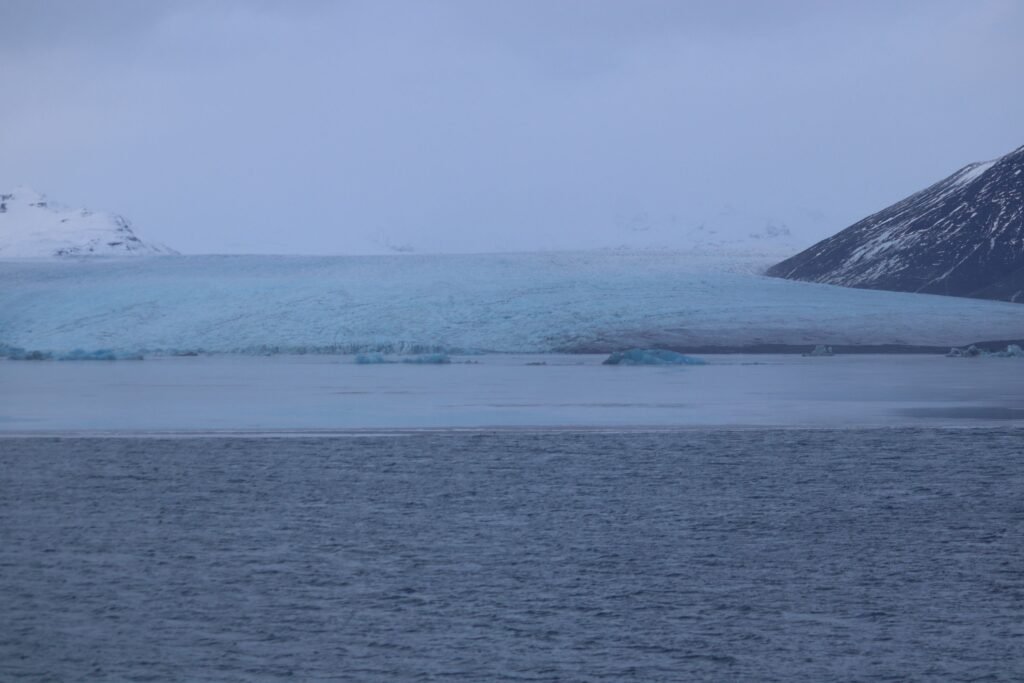
What Winter in South Iceland Is Really Like
I’m gonna be honest, winter in South Iceland isn’t exactly a walk in the park!
You can expect unpredictable (and often volatile) weather, incredibly short daylight hours, and gusty winds that blow up seemingly out of nowhere, bringing a bitter wind chill.
Roads can also be icy, but the drivers leading the tours are very used to the conditions and know exactly how to keep you safe.
But winter, in my experience, is also when Iceland feels most alive, raw and beautiful.
The powerful waterfalls are partially frozen, the black sand beaches are pounded by incredibly strong waves, and the soft winter light shows off Iceland’s majestic glaciers at their very best.
And, if you’re lucky, you might spot the Northern Lights on the way back too!
Katie’s Top Tip: The key to having a great time is preparation, so pack like you’re dressing for all four seasons at once! Thermal base layers, waterproof outerwear, sturdy boots and thick gloves are non-negotiable. Oh, and don’t forget a waterproof cover to use your camera or phone near the waterfalls!
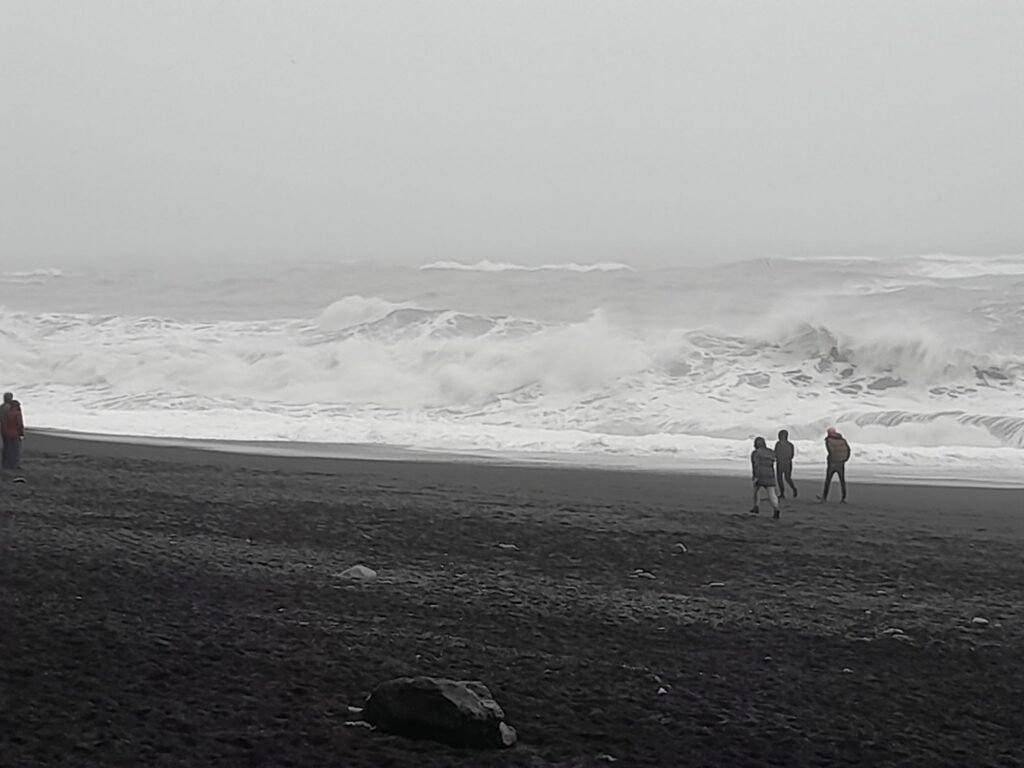
How to Visit Iceland’s South Coast From Reykjavik
Reykjavik is the perfect base for exploring the South Coast of Iceland, especially if you’re visiting without a car.
Most travellers visiting Iceland’s South Coast in winter take guided tours that depart early in the morning from the city centre and return by evening. Or they choose a 3-day South Coast tour with overnight stays, for a more relaxed pace.
The longest stretch of driving, regardless of whether you’re self-driving or on a tour, is about 379km (235 miles or approx. 5 hours’ drive) from Reykjavík to Jökulsárlón Glacier Lagoon.
And yeah, I get it, it’s such a long way (especially for a day trip), but reaching the otherworldly glacier lagoon makes it so worth it – and there is breathtaking scenery to admire the whole way!
Katie’s Top Tip: When planning how to visit Iceland’s South Coast from Reykjavik, check the daylight hours for your travel dates. The shorter they are (e.g. December and January), the more sense it makes to do a 3-day South Coast tour or multi-day Ring Road tour, instead of trying to fit everything into one long day.
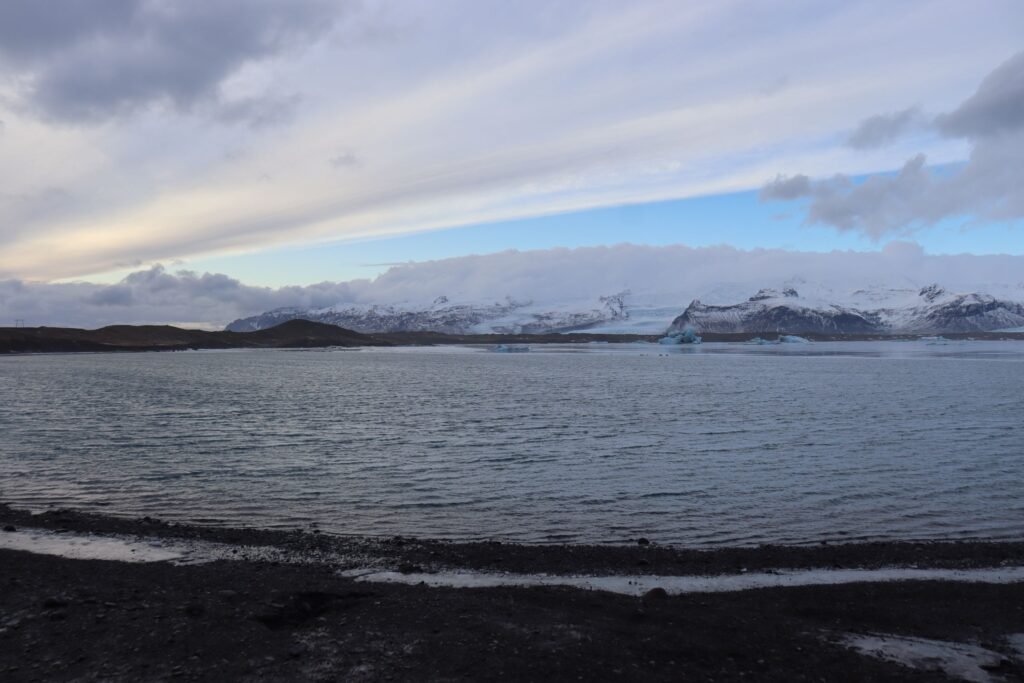
Visiting Iceland’s South Coast Without a Car
You don’t need to drive to experience the very best of Iceland’s South Coast in winter!
And honestly, I think it’s so much more relaxing without the stress of icy roads or navigating ever-changing and often volatile weather conditions solo.
I travelled the length of the South Coast over two days, entirely by joining small group tours from Reykjavik, and it was the best decision I made!
It let me see all the highlights safely and easily, meet other travellers, and focus on actually enjoying the experience instead of white-knuckling the steering wheel along the Ring Road!!
The tour companies I booked with were incredibly professional, and the guides shared local stories, myths and insider tips that made even the long drives so much fun!
Katie’s Top Tip: Book with reputable Icelandic tour operators (like the ones I will recommend in this guide) that offer flexible cancellation and small groups. I personally loved ICELANDIA, Arctic Adventures, Bus Travel Iceland and Troll Expeditions.
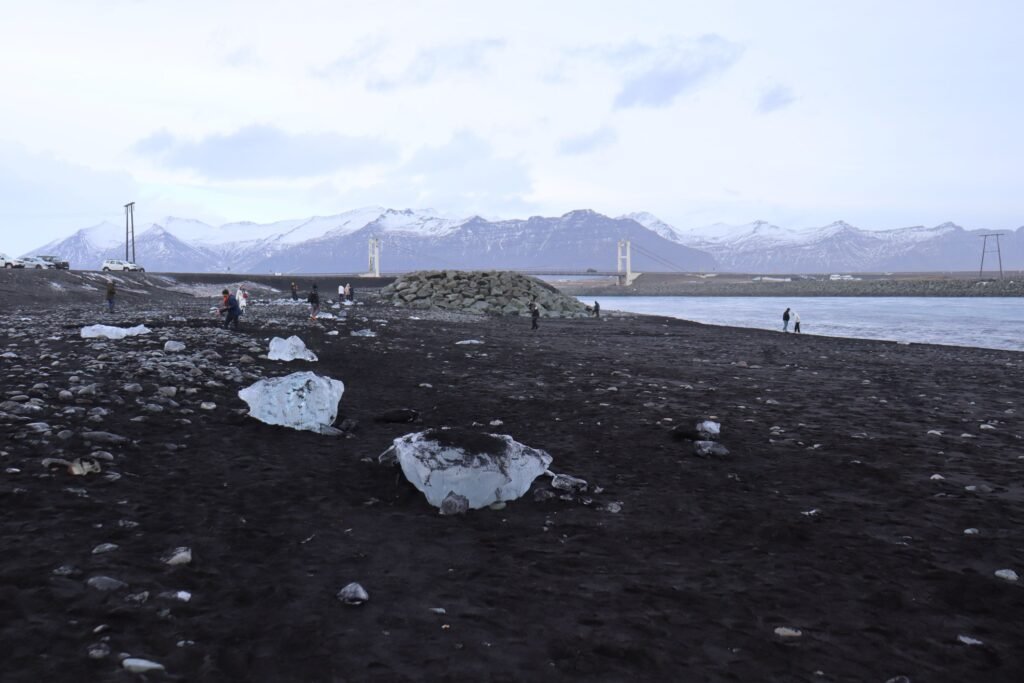
Best South Coast Iceland Tours in Winter
If you don’t want to drive, these are the best South Coast Iceland tours in winter I recommend:
Jökulsárlón Glacier Lagoon and Diamond Beach Tour From Reykjavik
This was one of the highlights of my entire 5 days in Iceland in January!
Be aware, it’s a very long day (about 14–15 hours), but it’s totally worth it.
On this amazing South Coast day trip, you’ll visit the truly stunning Jökulsárlón Glacier Lagoon, where huge icebergs drift on their journey out to sea, straight from the mighty Vatnajökull Glacier. You might also spot seals, lounging on the ice!
You’ll also visit Diamond Beach, where those same chunks of ice wash up on the jet black sand and sparkle like… diamonds! Even with cloudy skies like we had, it’s truly beautiful.
Plus, this tour includes stops at Seljalandsfoss and Skógafoss Falls and Vik Village.

Iceland South Coast Small-Group Adventure From Reykjavik
If you want to see the highlights of the South Coast Iceland without such a long day, this small-group South Coast tour that I also took is perfect.
You’ll get to see the South Coast’s most iconic spots, including Seljalandsfoss and Skógafoss Falls, Reynisfjara black sand beach (with its infamous sneaker waves), and the incredible Sólheimajökull Glacier.
And even though there are several repeats between this tour and the Jökulsárlón tour, I personally did both and don’t regret it at all!

3-Day South Coast Adventure
If you can stretch your time in Iceland, this 3-day guided tour with overnight stays is the best way to see Iceland’s South Coast without rushing.
You’ll tick off all of the best South Coast attractions, from Seljalandsfoss and Skógafoss Falls, to Reynisfjara Beach and Jökulsárlón Glacier Lagoon.
Plus, have the experience of a lifetime when you head inside the breathtaking Blue Ice Cave, underneath the largest glacier in Europe: Vatnajökull!
And, as a true cherry on top of these incredible 3 days in Iceland, you’ll also get to visit the stunning Golden Circle, ticking off another true Iceland must-see!
This 3-day tour is a more comprehensive way to experience visiting South Iceland in winter, and way less tiring than two back-to-back day trips, driving back and forth to Reykjavik.
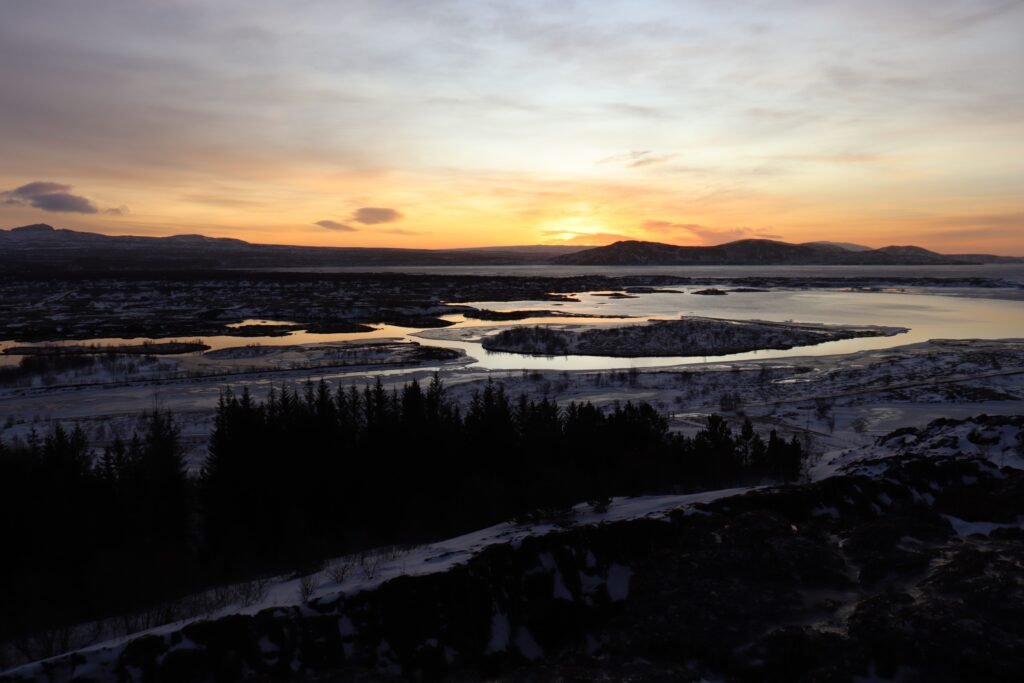
6–8 Day Ring Road Tours Including the South Coast
If you’re visiting Iceland for a week or more, I’d highly recommend doing a full Iceland Ring Road tour!
In 6 days touring the Ring Road, you’ll see all of the South Coast highlights, but also add in the iconic Golden Circle, a tour of the ice cave under the Vatnajökull Glacier, the underrated East Fjords, Lake Mývatn, and Akureyri in the north, to chase the Northern Lights!
In 8 days touring the Ring Road, you get all of that plus a visit to the incredible Snaefellsnes Peninsula, home to the iconic Game of Thrones mountain, Kirkjufell!
A guided Ring Road Tour is the most efficient way to see a lot of Iceland’s highlights, without having to drive yourself in winter conditions or backtrack to Reykjavik after each section!

Iceland South Coast Itinerary (Day 1)
If you’re self-driving, doing a one-day South Coast tour (or the first day of a longer 3, 6 or 8-day Iceland South Coast itinerary), this is the route you’ll follow!
It’s also the exact itinerary followed by the Iceland South Coast Small-Group Adventure from Reykjavik, which I personally took during my trip to Iceland in January.
This route covers the most famous highlights of Iceland’s South Coast, taking you to waterfalls, glaciers, black sand beaches, and coastal villages!
1. Seljalandsfoss Waterfall
Seljalandsfoss is the first big stop on any Iceland South Coast itinerary, and it absolutely lives up to the hype!
This waterfall is about 65m tall, and what makes it so special is that you can actually walk behind it and look out through the spray!
(Although keep in mind that, in winter, the path to do this is often closed due to icy conditions, so follow the latest signage and advice from your guide to stay safe.)
But even from the front viewpoint (just a short, easy walk from the car park), it’s truly breathtaking and easy to appreciate just how powerful this waterfall is!
Katie’s Top Tip: In January, I found the area around Seljalandsfoss to be incredibly icy. Wear waterproof boots with good grip and/or pack your own crampons to keep yourself safe.
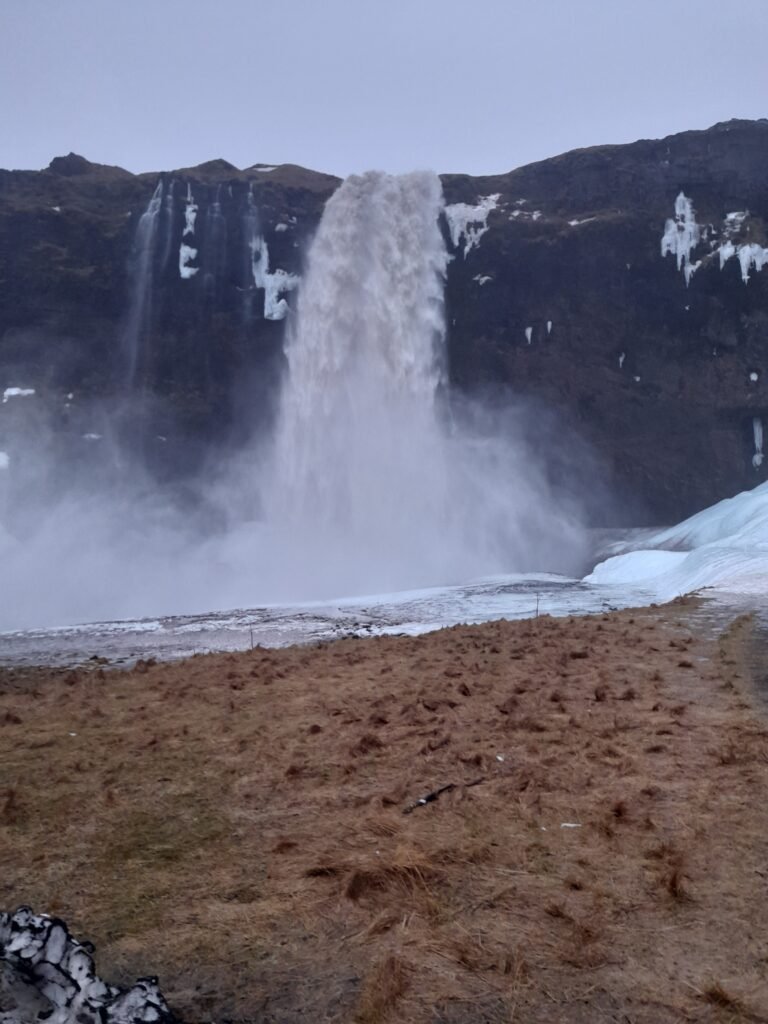
2. Skógafoss Waterfall
30 minutes further along the South Coast of Iceland is Skógafoss, another must-see waterfall in Iceland, which is often called one of the most photogenic spots in the country.
The falls are 25m wide and drop from an impressive height of 60m, creating a constant mist and spray that produces double rainbows on sunny days (or soaks you through if you stand too close – remember good waterproofs!)
Plus, in winter in South Iceland, Skógafoss shows its true power.
The steep cliffs surrounding the falls are dusted with snow, the surrounding paths are often icy (so take care walking!), and the roar of the water is something you have to hear in person to believe!
Katie’s Top Tip: You can climb the steps beside the waterfall for an incredible panoramic view. But it can close in winter, either due to wind or ice, so follow the signs and advice from your guide. And if you do decide to climb, take it slow and hold onto the rail.
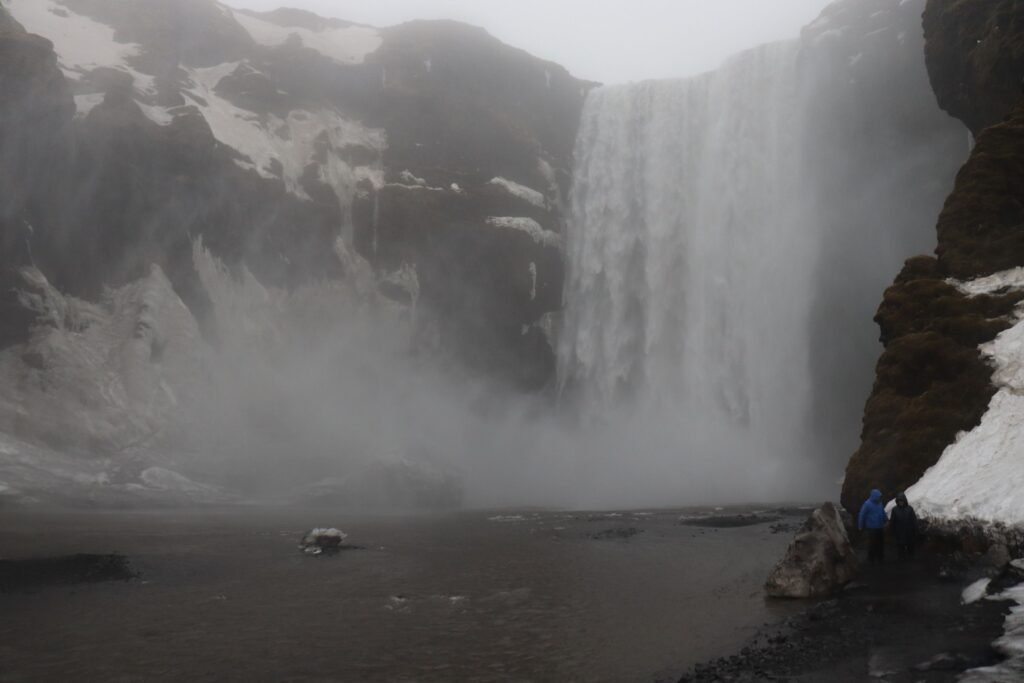
3. Reynisfjara Black Sand Beach
Reynisfjara Beach is most people’s highlight of the South Coast Iceland, and trust me, it is just as dramatic as it looks in photos – especially in winter, with the strong waves crashing against the shore!
The black volcanic sand, crashing waves, and towering basalt columns make it feel like you’re on another planet.
This beach is, in my opinion, the very best example of just how wild and powerful Iceland’s nature can be!
But Reynisfjara is also a place that you need to be respectful of.
The waves here are called “sneaker waves.” They are incredibly dangerous and can appear suddenly, pulling people into the sea without warning.
I’m not saying that to scare you or put you off visiting, but you should be smart and cautious, as people have died here even recently.
Katie’s Top Tip: Stay well back from the waterline, especially in winter when visibility can be lower and waves are often more powerful. Follow all of the latest signage and advice from your guide. And do not go inside the caves here.
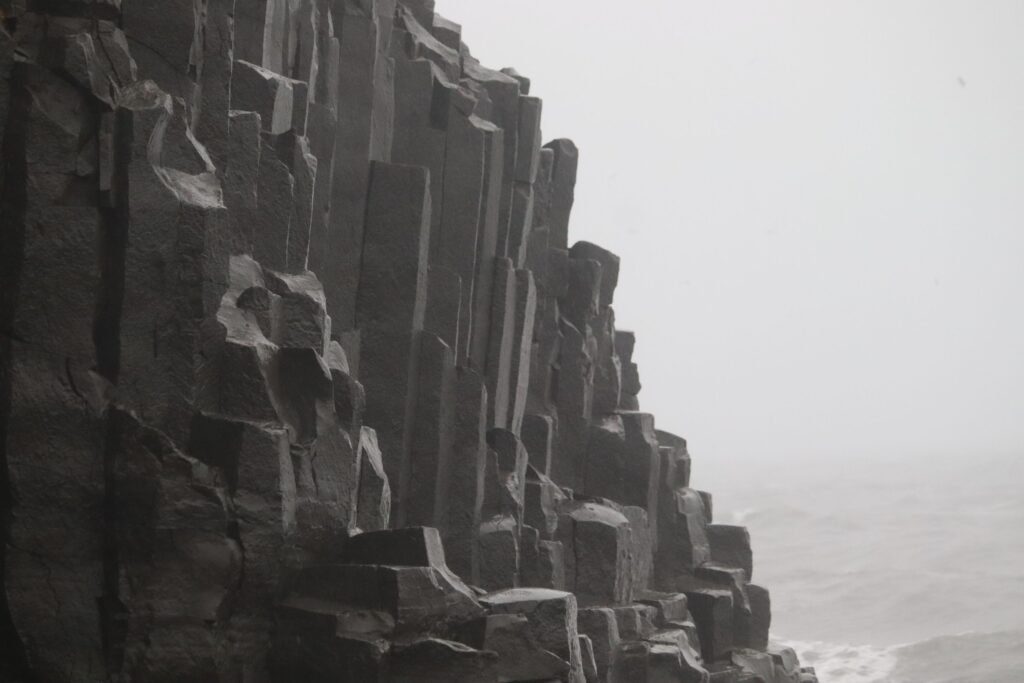
4. Vik Village and Church Viewpoint
The small community of Vik is the southernmost village in Iceland and one of the few places along this route where you’ll find a proper rest stop.
Even in the harshest winter conditions in South Iceland, Vik village feels cosy and welcoming for tourists!
The true highlight here, though, is the view from Vik church, which is perched on the hill overlooking the village and the coastline.
From the viewpoint, you can see Reynisdrangar, the famous sea stacks of the Reynisfjara Beach. It’s incredibly photogenic and well worth a stop!
Katie’s Top Tip: I made up a flask of hot chocolate in my hotel before I left and decided to drink it here while looking out at the view. It’s the perfect spot to slow down for a few minutes and enjoy a moment to yourself!

5. Sólheimajökull Glacier
If you’ve ever wanted to see a glacier up close (or even walk on one!) Sólheimajökull is your chance!
This outlet glacier is part of the larger Mýrdalsjökull ice cap, and is one of the most accessible glaciers in Iceland.
The Iceland South Coast tour that I took included a stop here for a short, relatively easy hike (around 15-20 minutes) to reach the glacier and walk along the edge, viewing it from the base.
But other tours, like this Sólheimajökull tour from Reykjavik, also allow you the opportunity to hike on the glacier itself in winter!
You hike alongside an experienced guide to help you navigate safely and are provided with all of the equipment you need. This is 100% on my bucket list for the future – it sounds like such a cool, once-in-a-lifetime opportunity!
It’s a rare chance to see and experience a glacier up close, rather than just from the edge!
Katie’s Top Tip: Never try to walk on the glacier alone. Book your glacier hike in advance and always go with a certified guide. The weather in South Iceland in winter changes fast, and professional guides have all the right gear (and know when to turn back if conditions change).

Iceland Southern Coast Itinerary (Day 2)
Day 2 of this Iceland South Coast itinerary was my personal favourite when I visited Iceland in January!
You’ll move beyond the most-visited beaches and waterfalls, and reach a part of South Iceland that takes longer (aka more effort) to get to, and is therefore much quieter.
I did this route on the Jökulsárlón Glacier Lagoon and Diamond Beach tour from Reykjavik, which honestly made it so easy to relax on the long drive and just enjoy the experience.
If you don’t want to self-drive, I would highly recommend:
- Jökulsárlón Glacier Lagoon and Diamond Beach Day Tour From Reykjavik
- 3-day South Coast Winter Tour (with the visit to the ice cave!)
- This 6-day Iceland Ring Road Tour
- Or this longer 8-day Iceland Ring Road tour (also includes the Snaefellsnes Peninsula)
Each of these amazing options will take you to every major highlight on this South Coast Iceland itinerary – without the stress of icy roads or navigating yourself in the dark!
1. Skógafoss Waterfall
This is the one main repeat between this tour and the Classic South Coast Tour (although you will skip this repeat if you book the multi-day South Coast tour instead).
But I personally took both South Coast day tours, and didn’t mind the repeat at all!
At 60m tall, Skógafoss is one of the most dramatic waterfalls in Iceland, and is well worth visiting (even twice!)
Katie’s Top Tip: Bring a waterproof outer layer, as even in winter, that powerful spray will soak you faster than you might think!

2. Diamond Beach
Few places in the world live up to their name like Diamond Beach does!
Iceland’s Diamond Beach is a stretch of jet-black volcanic sand, scattered with chunks of ice that have broken off from nearby glaciers and travelled through the Jökulsárlón Glacier Lagoon.
Once they are washed up on the beach, they glint like… diamonds! Especially against the dark sand.
It’s one of the main highlights of Iceland’s South Coast in winter, and honestly, photos don’t do it justice. It’s one of those places that’s always changing, and you have to visit in person for the full effect!
I just love that the ice chunks constantly shift with the tide, so every visit looks a little different.
Katie’s Top Tip: Stay back from the waterline. The waves at Diamond Beach are not like Reynisfjara’s, but they can still be unpredictable and have been known to surge. Keep your eyes on the tide at all times and stay on the drier sand.

3. Jökulsárlón Glacier Lagoon
Just across the road from Diamond Beach sits this day’s star attraction: the incredible Jökulsárlón Glacier Lagoon!
And if you’re wondering whether it’s worth the long drive from Reykjavik? My answer is, yes, it absolutely is!
Floating icebergs drift slowly through this majestic glacier lagoon, having broken off from the vast Vatnajökull ice cap.
The ice you see in this lagoon is between 1000-1500 years old!
Plus, the colours are unreal, especially in winter, with different shades of blue, white, and even volcanic streaks of ash sparkling in the soft, golden light.
This was hands down my favourite stop along Iceland’s South Coast in winter because it felt so remote, untouched and peaceful!
Katie’s Top Tip: If you’re a wildlife lover, be sure to bring binoculars or a good zoom lens, as if you’re lucky, you’ll be able to spot seals lounging on the ice here!

4. Seljalandsfoss Waterfall (Lit Up at Night)
If you’re doing two separate day trips from Reykjavik, you will have visited Seljalandsfoss on day 1, but seeing it lit up at night is a whole new experience!
The glow from the lights gives the icy cliffs a totally new and beautiful look, and I actually preferred seeing Seljalandsfoss at night, compared to during the day.
It just felt like I was seeing a whole new side to this famous waterfall that few other visitors get to experience! And that was so special.
If you’re returning to Reykjavik on the Jökulsárlón Glacier Lagoon and Diamond Beach tour, you’ll likely stop here briefly on the way back to see the waterfall lit up.
(Although this isn’t guaranteed, as tours often change up their schedules due to the weather or other conditions.)
But if you do get to visit at this magical time, know that it’s quiet, the crowds are gone, and it’s the perfect way to end your South Coast itinerary!
Katie’s Top Tip: If you are visiting in the evening, set your phone to “night mode” to capture the glow without any blur.

Weather in South Iceland in Winter
Okay, so as you’ve seen in the photos alongside my South Coast Iceland itinerary, the conditions here in winter can get a little crazy!
So let’s talk about the weather in South Iceland in winter, so you know what to expect.
Winter on the Iceland South Coast is roughly from November to March, with temperatures usually between -1°C and 5°C (so not as brutally cold as you might think!)
But what really catches people out (including me – I was not prepared!) is the wind.
Iceland is famous for its strong winds, and the wind chill they bring will make it feel much, much colder than the actual forecasted temperature.
Plus, if there’s another thing you should know about the weather in South Iceland in winter, it’s that “unpredictable” is its middle name!
Snow, sleet, rain, wind and glorious sunshine often all happen within the same hour – or at the very least the same day.
I remember when I was at Diamond Beach, it was raining hard, on and off. Then 30 minutes later, at Jökulsárlón Glacier Lagoon (just a few minutes away), there was glorious sunshine!
But honestly, that’s part of the beauty, drama and uniqueness of Iceland in winter!
Oh, and also remember that daylight is limited in winter, especially in December and January, when you might only get about 4–5 hours of proper light (if the weather plays ball!)
But don’t stress too much about logistics, as tours are carefully timed around this, so you won’t miss out.
Katie’s Top Tip: Keep your expectations flexible if you want to have a stress-free experience. In Iceland, I quickly learnt that the weather decides the plan, not you! I recommend using Vedur.is to check forecasts and wind speeds daily.

What to Pack for Iceland’s South Coast in Winter
Okay, so we’ve established that the weather in South Iceland in winter can get more than a little wild and crazy.
So what do you pack for that, when it’s so unpredictable?!
Well, packing for Iceland in winter is not about fashion. It’s about staying warm, dry and comfortable enough to actually enjoy all those incredible landscapes you’ll be seeing.
On tours, you’ll be outside a lot, standing still at waterfalls or walking on beaches in the howling wind.
But you’ll also be inside, travelling in a well-heated minibus for extended times too, so you don’t want to overheat just as much as you don’t want to freeze.
The solution? Layering:
- Start with thermal base layers (top and leggings)
- Then add a warm mid-layer like fleece or merino wool
- Finish with a waterproof, windproof, insulated coat
- Optionally, waterproof trousers are a great addition when it’s really rainy, snowy, or you’re standing near the spray of a powerful waterfall (looking at you, Skógafoss!!)
- Waterproof hiking boots with a good grip
- Warm thermal socks
- Insulated gloves
- A hat that covers your ears
- A scarf or a neck gaiter
Aside from clothing, I’d also recommend packing a power bank (the cold drains phone batteries quicker), a reusable water bottle, and plenty of snacks, as food stops are limited.
Katie’s Top Tip: I would also recommend packing your own slip-on crampons. They slip right over your boots and make a huge difference on icy paths!
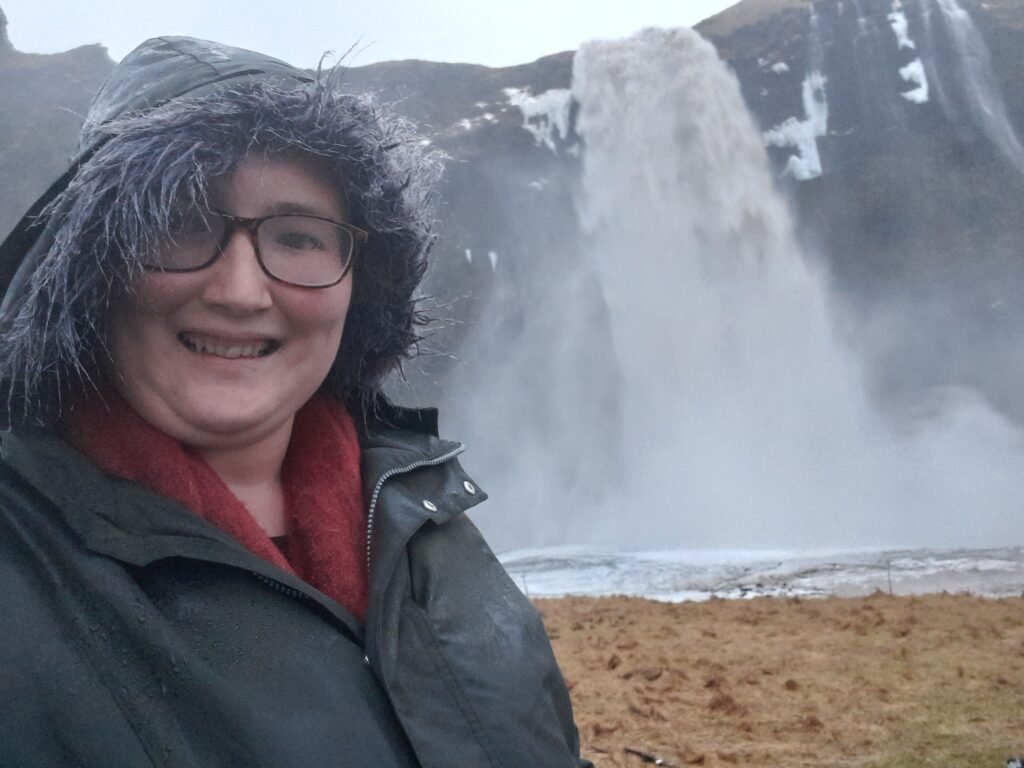
Best Things to Do on Iceland’s South Coast in Winter
If you just want a quick overview, here are the best things to do on Iceland’s South Coast in winter that you shouldn’t miss, whether you’re driving yourself or joining a tour:
- Seljalandsfoss: The famous waterfall you can walk behind if conditions allow (bring waterproofs for this!)
- Skógafoss: A 60m, incredibly powerful waterfall that often has stunning double rainbows if it’s sunny.
- Reynisfjara Black Sand Beach: The spot for dramatic basalt columns, striking black sands and wild waves!
- Vik Church Viewpoint: A peaceful spot overlooking the sea and village, with an incredible view out to the Reynisdrangar sea stacks.
- Sólheimajökull Glacier: Iceland’s most accessible glacier for walking along the edge or even hiking on the glacier itself, with an expert guide!
- Jökulsárlón Glacier Lagoon & Diamond Beach: Majestic icebergs that then wash up onto the stark black sands and glitter like diamonds.

Final Thoughts: Visiting South Iceland in Winter
Visiting South Iceland in winter might sound intimidating, with Iceland’s famous cold, short days, and unpredictable weather, but really, it’s one of the best travel experiences you can have!
Iceland’s famous South Coast is a lot calmer and quieter at this time of year, which you just don’t get to experience in summer.
For me, as a solo female traveller, that peacefulness and space to enjoy Iceland’s most dramatic landscapes as they are meant to be seen (calm, rather than full of tour buses!), is what I loved most.
I’ll never, ever forget standing alone at a corner of the mighty Jökulsárlón Glacier Lagoon, staring out at the huge 1000-year-old icebergs and adorable seals, cast in a soft winter light.
I’ve solo-travelled to 24+ countries, but that remains one of my all-time favourite travel memories!
So, whether you’re joining the Classic South Coast and Jökulsárlón Glacier Lagoon day trips from Reykjavik that I took, or planning a longer Iceland itinerary, with either a 3-day South Coast tour or an 8-day Iceland Ring Road tour, I promise this beautiful part of the country is so worth visiting!
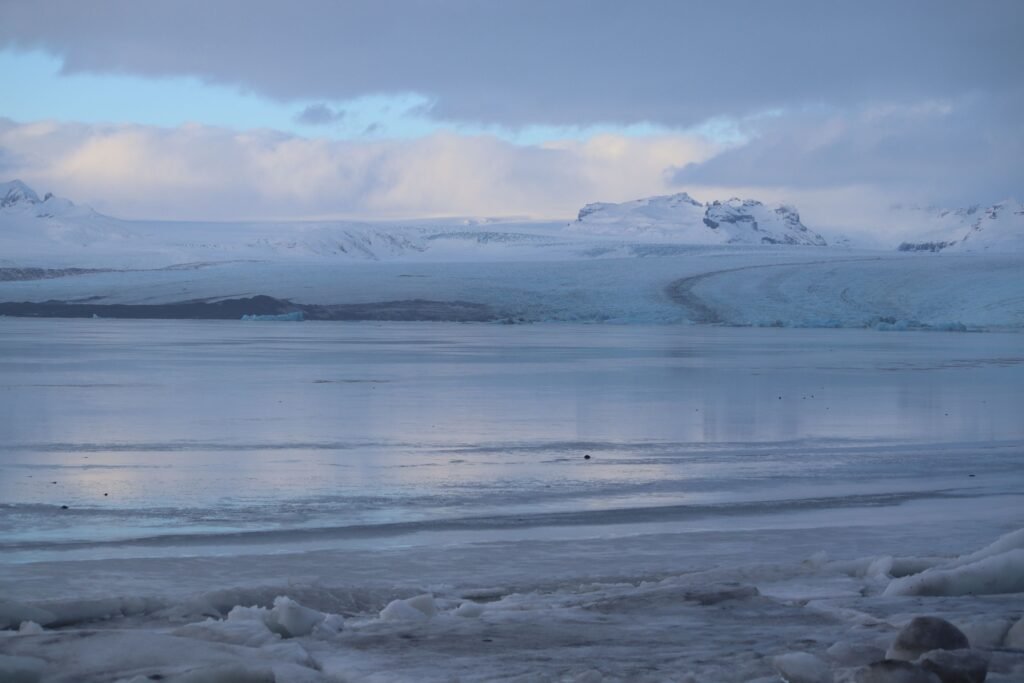
FAQs About Visiting Iceland’s South Coast in Winter
Is Jökulsárlón Glacier Lagoon worth visiting from Reykjavík?
Yes! Jökulsárlón Glacier Lagoon is absolutely worth visiting from Reykjavík, even in winter.
It’s one of those places that can’t fail to impress you, especially under the soft winter light, with huge, 1000-year-old icebergs drifting across the lagoon and cute seals bobbing between them!
But I get it, it’s a long day (around 5 hours each way), so it’s best enjoyed as part of a 3-day Iceland South Coast tour or an 8-day full Iceland Ring Road tour.
If you are based solely in Reykjavik, though, don’t worry! This amazing 1-day tour from Reykjavik that I took was a long day (14-15 hours), but so well organised and worth doing!
Can you visit Iceland’s South Coast in winter without a car?
Yes, and I actually did!
It’s completely possible to visit the South Coast of Iceland in winter without renting a car, thanks to some amazing day tours and multi-day small-group trips, lasting 3 days, 6 days or 8 days.
These are perfect if you’re travelling solo or don’t feel confident driving, as you won’t have to worry about icy roads, timing your days around limited light, or driving in unpredictable weather!
All tours leave directly from Reykjavik city centre, regardless of whether you’ve booked a 1-day or multi-day tour, and cover all of the highlights of the South Coast.
The longer, multi-day tours even include a visit to the incredible ice cave under the Vatnajökull Glacier (Europe’s largest!)
How many days do you need for Iceland’s South Coast in winter?
Ideally, give yourself at least two full days to experience the best of Iceland’s South Coast in winter.
That allows time for you to visit the major waterfalls, black sand beaches, and glacier lagoons without rushing.
If you can stretch it to three days, that’s even better, as you’ll be able to take an ice cave tour under the Vatnajökull Glacier!
But if you only have one day, don’t worry! Just focus on the section between Seljalandsfoss and Vik, with this classic South Coast day trip, as it’s closer to Reykjavik and still very scenic.
Is it safe to visit Iceland’s South Coast in winter?
Yes! Visiting Iceland’s South Coast in winter is safe, as long as you respect nature and the weather.
Be aware that roads can be icy, the wind can be fierce, and snowstorms often appear suddenly, so always check the Icelandic Road and Coastal Administration website before heading out, especially if you’re self-driving.
And if you’re not used to winter driving, joining a guided tour is the safest choice.
In terms of personal safety, Iceland is one of the safest countries in the world, and you can read more about solo female travel safety in Iceland in my latest blog post.
What’s the weather like on Iceland’s South Coast in winter?
The weather in South Iceland in winter is surprisingly mild compared to other Scandinavian countries (and even other parts of Iceland), thanks to the Gulf Stream.
In winter, average temperatures are around 0°C, with regular wind (that can make temperatures feel a lot colder) and rain, and occasional snow.
Just don’t expect predictability here! One moment it’s blue skies and sun, then in the next moment, you’ve got rain and thick fog!
This unpredictability is what makes Iceland so magical and raw in winter, but it also means you need to be prepared for anything, with waterproof outer layers and warm base layers.
Read More About Travel in Iceland:
- The Ultimate Iceland Solo Female Travel Guide (For 2025!)
- Iceland’s Snaefellsnes Peninsula in Winter (Without a Car!)
- How to Visit Iceland’s South Coast in Winter (Without a Car)
- 7 Unmissable Day Trips From Reykjavik in Winter (No Car!)
- How to See Iceland’s Golden Circle in Winter (Without a Car)
- Iceland’s Blue Lagoon in Winter: What to Expect (and Pack!)
- 15 Iceland Travel Tips for Winter You’ll Be Glad You Know
- How Many Days Do You Need in Iceland in Winter?
- How to Spend 5 Days in Iceland in Winter (Without A Car!)
- 19 Prettiest Places in Iceland Every Traveller Must See
- Is Iceland Worth Visiting in Winter? What You Must Know
- Is Iceland Safe For Solo Female Travellers? An Honest Guide


One Comment